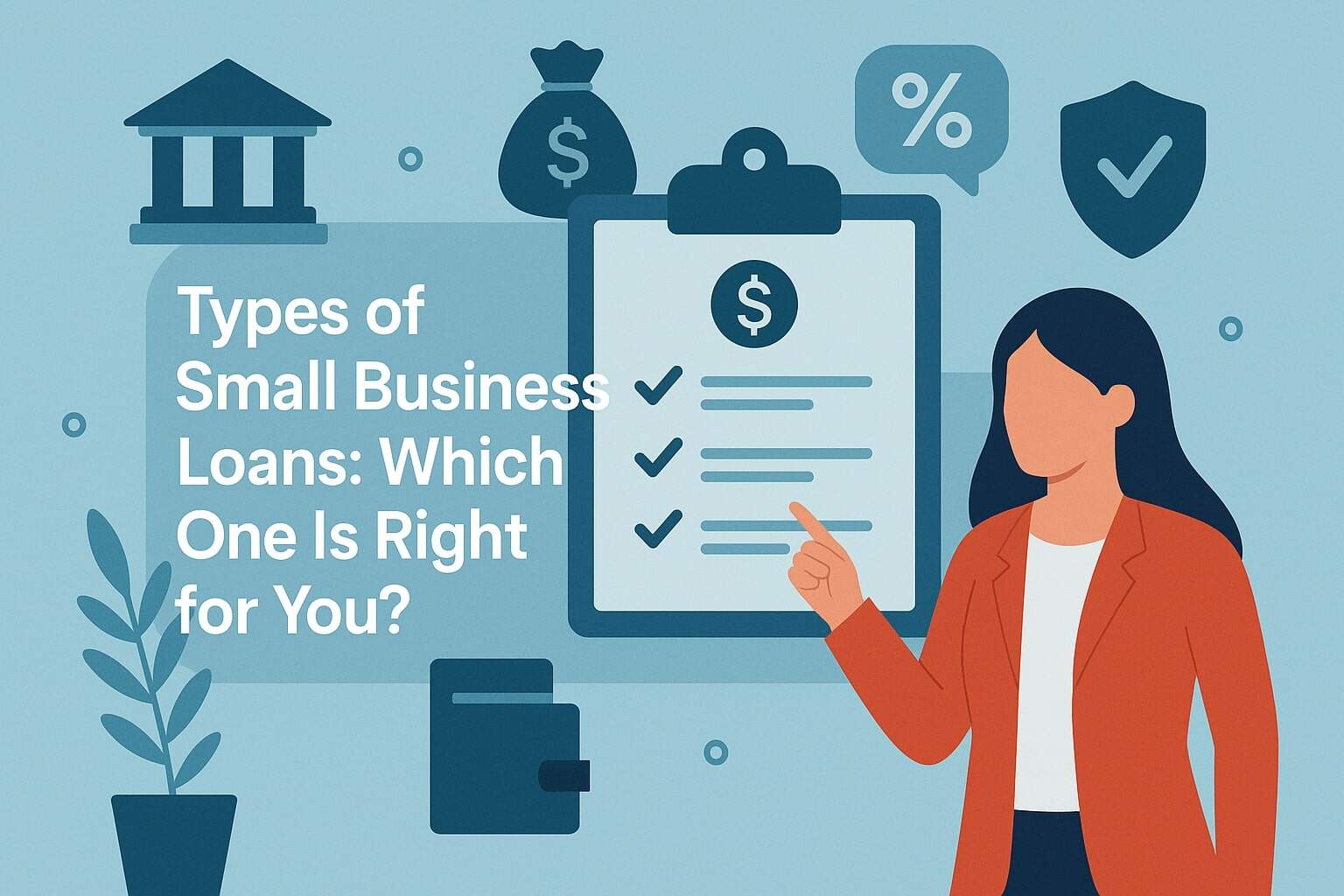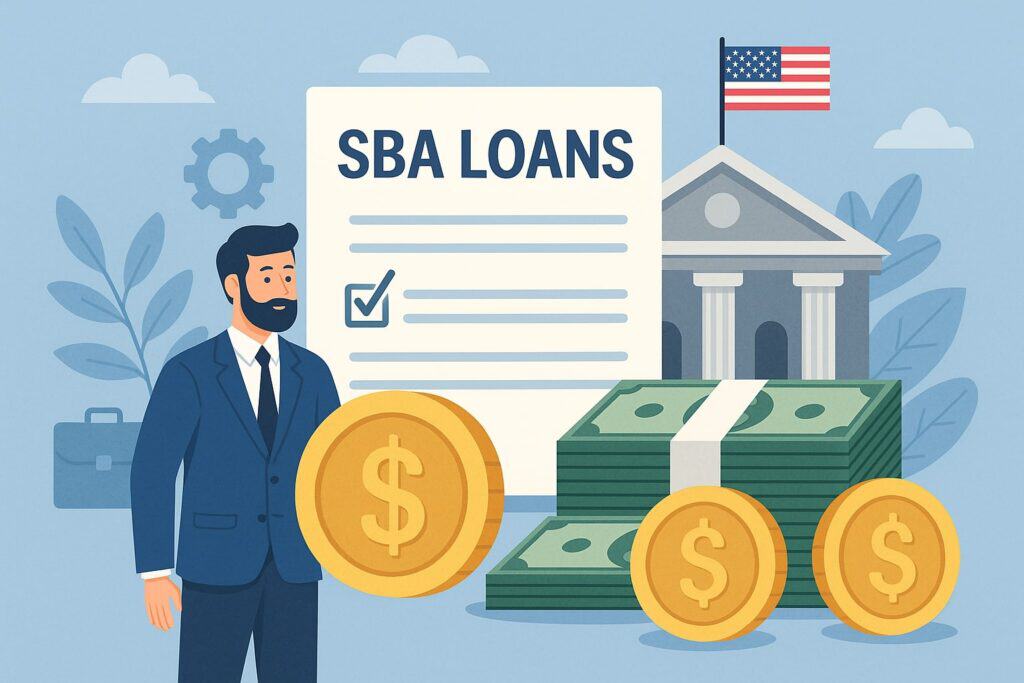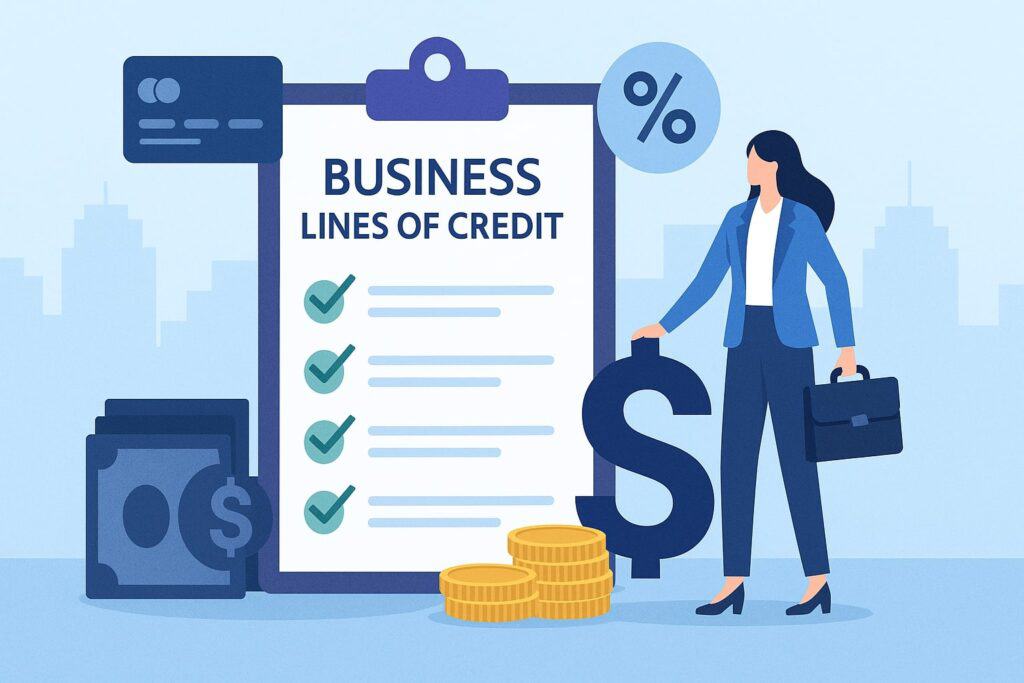
Types of Small Business Loans: Which One Is Right for You?
Starting, growing, or sustaining a small business often requires outside funding. Whether you need cash to cover operating expenses, purchase equipment, hire new staff, or manage seasonal slowdowns, small business loans can provide the financial lifeline necessary to achieve your goals.
However, choosing the right type of loan can be overwhelming because lenders offer a wide variety of financing options, each with its own requirements, repayment terms, and best-use cases.
This guide explores the major types of small business loans, explaining their features, benefits, drawbacks, and ideal use scenarios. By the end, you’ll be equipped with the knowledge to identify the loan that fits your business’s needs and long-term strategy.
Traditional Term Loans for Small Businesses

A term loan is one of the most common forms of small business financing. With this type of loan, a lender provides a lump sum of money upfront, and the borrower repays it over a predetermined period with interest.
Term loans are often offered by banks, credit unions, and online lenders. They can range from short-term loans (3–18 months) to long-term loans (up to 25 years, depending on the purpose and lender).
Key features of term loans include predictable repayment schedules, fixed or variable interest rates, and higher borrowing limits compared to other financing products. This makes them ideal for large one-time investments such as expanding a location, purchasing expensive equipment, or funding a new marketing campaign.
The advantages of term loans lie in their stability and structured repayment plans. Business owners know exactly how much they owe each month, making it easier to plan budgets. Long-term loans generally offer lower monthly payments, though they may accumulate more interest over time.
However, downsides exist. Banks often require strong credit scores, collateral, and detailed financial statements before approving a loan. The application process can also be lengthy and paperwork-heavy, which may not suit businesses in urgent need of funds.
Despite these challenges, term loans remain a foundational financing option for businesses with solid financial histories and long-term growth plans. For example, a restaurant owner planning to open a second location could use a 10-year term loan to cover buildout and furnishing costs while paying it back gradually from profits.
SBA Loans: Government-Backed Funding Options

The Small Business Administration (SBA) partners with approved lenders to provide loans designed specifically for small businesses. While the SBA itself doesn’t directly lend money, it guarantees a portion of the loan, reducing risk for lenders and enabling them to offer more favorable terms to borrowers.
SBA loans come in several forms:
- SBA 7(a) Loans – The most popular, these cover general business purposes like working capital, equipment purchases, or refinancing debt. Loan amounts can go up to $5 million with repayment terms of up to 25 years.
- SBA 504 Loans – Targeted for purchasing fixed assets like real estate or machinery, these loans are structured with a bank providing 50%, an SBA-approved Certified Development Company providing 40%, and the borrower contributing 10%.
- SBA Microloans – Smaller loans of up to $50,000, often provided by nonprofit community lenders, ideal for startups or businesses needing modest funding.
- SBA Disaster Loans – Available for businesses affected by natural disasters, providing low-interest financing to help recover operations.
The main benefits of SBA loans are their relatively low interest rates, long repayment terms, and flexibility in usage. They can be significantly more affordable than traditional bank loans, making them a top choice for qualified businesses.
But, drawbacks include a lengthy application process, strict eligibility requirements, and substantial documentation. Borrowers may wait weeks or even months before receiving funds. Additionally, collateral and personal guarantees are often required.
For entrepreneurs willing to navigate the paperwork, SBA loans represent some of the best financing options for growing small businesses, especially those that need larger amounts of capital with manageable repayment terms.
Business Lines of Credit

A business line of credit works differently than a term loan. Instead of receiving a lump sum, the lender approves a credit limit that the business can draw from as needed. You only pay interest on the amount you borrow, not the total credit line.
Lines of credit can be secured (backed by collateral like inventory or receivables) or unsecured (no collateral required, but usually harder to qualify for). Credit limits often range from $10,000 to several hundred thousand dollars, depending on the business’s financial health.
The greatest advantage of a line of credit is flexibility. It functions much like a credit card, allowing business owners to draw, repay, and redraw funds repeatedly as long as they stay within their limit. This makes it especially useful for managing cash flow gaps, covering unexpected expenses, or handling seasonal fluctuations.
Another benefit is that interest charges only apply to the amount borrowed, not the entire line. This can save businesses money compared to term loans if the borrowed funds are managed responsibly.
However, businesses must be cautious. Lines of credit may come with variable interest rates, meaning payments could rise unexpectedly. Lenders may also impose annual fees or withdrawal fees. Additionally, businesses with poor financial management could overdraw and struggle to repay.
For example, a landscaping company with seasonal peaks in spring and summer could use a line of credit to cover payroll during the slower winter months, repaying the balance once revenue increases again.
Equipment Financing
For businesses that need specialized tools, vehicles, or machinery, equipment financing is often the best choice. This loan type is specifically designed for purchasing equipment, with the equipment itself serving as collateral.
Equipment loans usually cover up to 100% of the equipment’s cost, allowing businesses to acquire necessary assets without paying upfront. Repayment terms generally align with the expected lifespan of the equipment, ranging from 2 to 10 years.
Benefits include easier approval compared to traditional loans, since the equipment itself reduces the lender’s risk. Interest rates are often competitive, and businesses can preserve working capital for other expenses. Equipment financing is particularly popular in industries like construction, healthcare, and manufacturing.
The main downsides involve depreciation and obsolescence. If equipment loses value quickly, businesses may still be repaying the loan long after the asset has become outdated. Also, if payments are missed, lenders can repossess the equipment.
Overall, equipment financing is ideal for businesses that rely heavily on machinery or technology to operate. For instance, a medical clinic purchasing advanced diagnostic tools might use this loan to spread out costs while generating revenue from the equipment.
Invoice Financing and Factoring
Cash flow problems often arise when clients delay payments. Invoice financing and invoice factoring are solutions designed to address this challenge by allowing businesses to borrow against unpaid invoices.
With invoice financing, a lender advances a percentage (often 70–90%) of outstanding invoices. Once customers pay, the business repays the advance plus fees. In invoice factoring, businesses sell their invoices to a factoring company at a discount, and the factoring company collects directly from customers.
Advantages of invoice financing include faster access to cash, no need for additional collateral, and easier qualification since approval is based on customer creditworthiness. This option is especially helpful for businesses with reliable clients but long payment cycles.
Drawbacks include potentially high fees, loss of control over customer relationships (in factoring arrangements), and dependence on customer reliability. If clients fail to pay, the business remains liable in most financing agreements.
For example, a small B2B company that provides marketing services to corporate clients with 60-day payment terms could use invoice financing to cover immediate payroll and rent while waiting for invoice payments.
Merchant Cash Advances (MCAs)
A merchant cash advance (MCA) provides upfront funding in exchange for a percentage of future credit card or debit card sales. Unlike a loan, this is considered a sale of future receivables. Repayments are automatically deducted from daily or weekly sales, making MCAs convenient but often very expensive.
The biggest advantage is accessibility. Businesses with poor credit or limited financial history can often qualify if they have strong card-based sales. The funding process is quick, sometimes within 24–48 hours, making MCAs a go-to option for businesses facing urgent expenses.
However, the downsides are significant. Effective annual percentage rates (APRs) for MCAs can exceed 50% or even 100%, making them one of the most expensive financing forms. Daily or weekly deductions can also strain cash flow, especially during slow periods.
MCAs are best considered a last-resort option for businesses that need fast money and lack access to traditional loans. For example, a retail shop experiencing a sudden equipment breakdown may use an MCA to repair or replace equipment immediately, though it comes at a steep cost.
Microloans
Microloans are small loans, usually under $50,000, offered by nonprofits, community lenders, or specialized programs. They are designed to support startups, women-owned businesses, minority entrepreneurs, and underserved communities.
These loans often come with more flexible qualification criteria, lower interest rates, and access to mentorship or business training resources. Microloans are particularly helpful for entrepreneurs who don’t yet qualify for traditional financing.
On the downside, microloans may not provide enough funding for larger projects. The application process can still be time-consuming, and interest rates, while lower than credit cards or MCAs, may be higher than SBA loans.
Despite these limitations, microloans play a critical role in enabling small businesses to launch or expand. For example, a startup baker who needs $20,000 for ovens, ingredients, and marketing could secure a microloan to get the business off the ground.
Personal Loans for Business Use
Some entrepreneurs use personal loans to fund their businesses, especially in the early stages when business credit isn’t established. These loans are based on the borrower’s personal credit history, not the business’s financials.
Advantages include quicker approval, fewer restrictions on usage, and accessibility for startups with no operating history. Personal loans are also unsecured, so no collateral is required.
However, the risks are significant. Borrowers are personally liable for repayment, and defaulting could damage their credit and personal finances. Interest rates may also be higher than business-specific loans.
Personal loans can be practical for very small businesses or sole proprietors needing modest funding to get started. For example, a freelance graphic designer might use a personal loan to purchase a new computer and design software before building business credit.
FAQs
Q1. What factors should I consider before choosing a loan?
Answer: When choosing a loan, business owners should evaluate the purpose of the loan, repayment capacity, credit requirements, interest rates, and the speed of funding.
It’s important to ask: Do I need cash immediately, or can I wait for a more favorable option? Am I borrowing for long-term investment or short-term cash flow needs? Each loan type carries unique costs and risks, so aligning the loan’s structure with your business’s financial health and goals is critical.
Additionally, consider your risk tolerance. For example, secured loans with collateral may offer lower rates but put your assets at risk if you default. Conversely, unsecured loans are safer for assets but may come with higher interest. Comparing multiple lenders and understanding the fine print can help you avoid pitfalls.
Q2. How does my credit score affect loan eligibility?
Answer: Credit scores are a major factor in loan approval. A high score signals to lenders that you are a reliable borrower, improving your chances of approval and helping you secure better interest rates. Conversely, a low score can limit options, pushing you toward higher-cost loans like merchant cash advances or alternative online lenders.
However, credit score isn’t the only factor. Lenders also evaluate revenue, business age, industry, and cash flow. For example, an established business with steady income may still secure financing even if its credit score isn’t perfect. Building and maintaining good credit, however, expands your financing choices significantly.
Q3. Are online lenders a good option for small businesses?
Answer: Yes, online lenders can be a good fit, especially for businesses that need fast funding or don’t qualify for traditional bank loans. Many online lenders provide streamlined applications, quick approvals, and more flexible eligibility requirements. They often specialize in short-term loans, lines of credit, or merchant cash advances.
The tradeoff is that online lenders typically charge higher interest rates than banks or SBA-backed loans. Business owners should weigh convenience against cost. If you need money within days rather than weeks, online lenders can be invaluable, but always read terms carefully to avoid hidden fees or unsustainable repayment structures.
Conclusion
Small business loans are not one-size-fits-all. The best choice depends on your business’s stage, financial health, credit history, and funding needs. For long-term investments, SBA loans or traditional term loans may be ideal.
For flexibility, a business line of credit offers ongoing access to cash. For equipment-heavy industries, equipment financing makes sense, while startups and underserved entrepreneurs may find microloans more accessible.
Before committing, take time to assess your financial situation, compare offers, and consult financial advisors if necessary. Choosing the right loan not only provides the capital you need but also ensures your business can manage repayments sustainably.